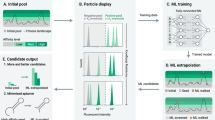Abstract
Aptamers are nucleic acid molecules selected in vitro to bind a particular ligand. While numerous experimental studies have examined the sequences, structures, and functions of individual aptamers, considerably fewer studies have applied bioinformatics approaches to try to infer more general principles from these individual studies. We have used a large Aptamer Database to parse the contributions of both random and constant regions to the secondary structures of more than 2000 aptamers. We find that the constant, primer-binding regions do not, in general, contribute significantly to aptamer structures. These results suggest that (a) binding function is not contributed to nor constrained by constant regions; (b) in consequence, the landscape of functional binding sequences is sparse but robust, favoring scenarios for short, functional nucleic acid sequences near origins; and (c) many pool designs for the selection of aptamers are likely to prove robust.





Similar content being viewed by others
References
Ancel L, Fontana W (2000) Plasticity, modularity and evolvability in RNA in vitro. Exp Zool 288:242–283
Bartel DP, Szostak JW (1993) Isolation of new ribozymes from a large pool of random sequences. Science 261:1411–1417
Carothers JM, Oestreich SC, Davis JH, Szostak JW (2004) Informational complexity and functional activity of RNA structures in vitro. Am Chem Soc 126:5130–5137
Coleman TM, Huang F (2002) RNA-catalyzed thioester synthesis. Chem Biol 9:1227–1236
Coleman TM, Huang F (2005) Optimal random libraries for the isolation of catalytic RNA. RNA Biol 2:129–136
Connell GJ, Illangesekare M, Yarus M (1993) Three small ribooligonucleotides with specific arginine sites. Biochemistry 32:5497–5502
Davidson EA, Ellington AD (2005) Engineering regulatory RNAs. Trends Biotechnol 23:109–112
Dey AK, Griffiths C, Lea SM, James W (2005) Structural characterization of an anti-gp120 RNA aptamer that neutralizes R5 strains of HIV-1. RNA 11:873–884
Doudna JA (2000) Structural genomics of RNA. Nature Struct Biol 7:954–956
Ellington AD (1994) RNA selection. Aptamers achieve the desired recognition. Curr Biol 4:427–429
Ellington AD, Szostak JW (1990) In vitro selection of RNA molecules that bind specific ligands. Nature 346:818–822
Ellington AD, Khrapov M, Shaw CA (2000) The scene of a frozen accident. RNA 6:485–498
Gevertz J, Gin HH, Schlick T (2005) In vitro RNA random pools are not structurally diverse: a computational analysis. RNA 11:853–863
Hall B, Hesselberth JR, Ellington AD (2007) Computational selection of nucleic acid biosensors via a slip structure model. Biosens Bioelectron 22:1939–1947
Hofacker IF, Fontana W, Stadler BF, Bonhoeffer S, Tacker M, Schuster P (1994) Fast folding and comparison of RNA secondary structures. Monatshefte Chemie 125:167–188
Huang Z, Szostak JW (2003) Evolution of aptamers with a new specificity and new secondary structures from an ATP aptamer. RNA 9:1456–1463
Hughes RA, Robertson MP, Ellington AD, Levy M (2004) The importance of prebiotic chemistry in the RNA world. Curr Opin Chem Biol 8:629–633
Isaacs FJ, Dwyer DJ, Collins JJ (2006) RNA synthetic biology. Nature Biotechnol 24:545–554
Jhaveri SD, Hirao I, Bell S, Uphoff KW, Ellington AD (1997) Landscapes for molecular evolution: lessons from in vitro selection experiments with nucleic acids. Annu Rep Comb Chem Mol Divers 1:169–191
Joyce GF (2000) RNA structure: ribozyme evolution at the crossroads. Science 289:401–402
Joyce GF (2004) Directed evolution of nucleic acid enzymes. Annu Rev Biochem 73:791–836
Kim N, Gan HH, Schlick T (2007) A computational proposal for designing structured RNA pools for in vitro selection of RNAs. RNA 13:478–492
Knight R, Yarus M (2003) Analyzing partially randomized nucleic acid pools: straight dope on doping. Nucleic Acids Res 31:e30
Lee JF, Hesselberth JR, Meyers LA, Ellington AD (2004) Aptamer Database. Nucleic Acids Res 32:D95–D100
Lee JF, Stovall GM, Ellington AD (2006) Aptamer therapeutics advance. Curr Opin Chem Biol 10:282–289
Legiewicz M, Lozupone C, Knight R, Yarus M (2005) Size, constant sequences, and optimal selection. RNA 11:1701–1709
Lozupone C, Changayil S, Majerfeld I, Yarus M (2003) Selection of the simplest RNA that binds isoleucine. RNA 9:1315–1322
Majerfeld I, Yarus M (1998) Isoleucine: RNA sites with associated coding sequences. RNA 4:471–478
Mathews DH, Sabina J, Zuker M, Turner DH (1999) Expanded sequence dependence of thermodynamic parameters improves prediction of RNA secondary structure in vitro. Mol Biol 288:911–940
McCaskill JS (1990) The equilibrium partition function and base pair binding probabilities for RNA secondary structure. Biopolymers 29:1105–1109
Meyers LA, Lee JF, Cowperthwaite MC, Ellington AD (2004) The robustness of naturally and artificially selected nucleic acid secondary structures in vitro. Mol Evol 58:618–625
Patzel V (2004) In silico selection of functional RNA molecules. Curr Opin Drug Disc Dev 7:360–369
Sabeti PC, Unrau PJ, Bartel DP (1997) Accessing rare activities from random RNA sequences: the importance of the length of molecules in the starting pool. Chem Biol 4:767–774
Salehi-Ashtiani K, Szostak JW (2001) In vitro evolution suggests multiple origins for the hammerhead ribozyme. Nature 414:82–84
Sayer NM, Cubin M, Rhie A, Bullock M, Tahiri-Alaoui A, James W (2004) Structural determinants of conformationally selective, prion-binding aptamers. J Biol Chem 279:13102–13109
Schultes EA, Bartel DP (2000) One sequence, two ribozymes: implications for the emergence of new ribozyme folds. Science 289:448–452
Schuster P, Fontana W, Stadler P, Hofacker I (1994) From sequences to shapes and back: a case study in RNA secondary structures. Proc Roy Sci Lond B 255:279–284
Tuerk C, Gold L (1990) Systematic evolution of ligands by exponential enrichment: RNA ligands to bacteriophage T4 DNA polymerase. Science 249:505–510
Ulrich H (2006) RNA aptamers: from basic science towards therapy. Handbk Exp Pharmacol 173:305–326
Wuchty S, Fontana W, Hofacker IL, Schuster P (1999) Complete suboptimal folding of RNA and the stability of secondary structures. Biopolymers 49:145–165
Zuker M (1989) On finding all suboptimal foldings of an RNA molecule. Science 244:48–52
Zuker M, Stiegler P (1981) Optimal computer folding of large RNA sequences using thermodynamics and auxiliary information. Nucleic Acids Res 9:133–148
Author information
Authors and Affiliations
Corresponding author
Rights and permissions
About this article
Cite this article
Cowperthwaite, M.C., Ellington, A.D. Bioinformatic Analysis of the Contribution of Primer Sequences to Aptamer Structures. J Mol Evol 67, 95–102 (2008). https://doi.org/10.1007/s00239-008-9130-4
Received:
Revised:
Accepted:
Published:
Issue Date:
DOI: https://doi.org/10.1007/s00239-008-9130-4




